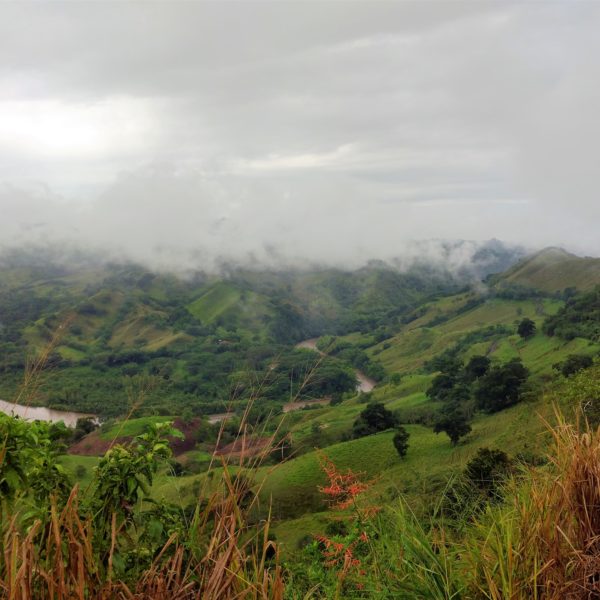The U.S. Global Development Lab (Lab) and the Bureau for Food Security are collaborating in an effort called “Digital Development for Feed the Future” (D2FTF) with the goal of demonstrating that digital tools and approaches can improve cost-effectiveness and better development outcomes in food security and nutrition programming. This blog features the case study on the International Center for Tropical Agriculture (CIAT) and how CIAT is driving agricultural outcomes with practical and data-driven tools.
In the developed world, the proliferation of reliable mobile connectivity and low-cost digital tools makes a wealth of information available for everyday decisions. Complex, but user-friendly, technologies put simple and reliable information into the hands of millions of people to support decisions across a wide range of industries and daily tasks. However, for farmers in the developing world, it’s a different story. These trends have been slow to translate into a developing country-context, resulting in farmers with lower access to quality information. Many farmers are facing new challenges from climate variability and social and economic shifts and make decisions in the absence of information specific to their context. After decades of working to close yield gaps through better crop varieties and management practice, the International Center for Tropical Agriculture (CIAT) saw an opportunity to achieve better agricultural outcomes with practical and data-driven tools that addressed farmer information gaps.
CIAT is a CGIAR center that works in 53 countries in Latin America, Africa, and Asia, focusing its research on tropical agriculture, with a strong emphasis on climate and environmental degradation. In 2008, CIAT began testing a new analytical approach called data-driven agronomy to improve on-farm decisions and yields. This approach analyzes data about the interaction of soils, climate, and management practices and converts it into simple information to help farmers make better decisions about how to manage their crops. CIAT has refined the approach in collaboration with several partners to help explain why farmers were experiencing poor or declining yields, particularly in the context of climate variability.
For one week in November 2017, I traveled to Colombia with two colleagues to meet CIAT researchers and stakeholders from its partners, Fedearroz, Asohofrucol, Fenalce (national rice, fruit, and maize associations), and the Ministry of Agriculture and Rural Development (MARD) in Pereira. We learned that the story of data-driven agronomy is about much more than analytical tools: CIAT’s work is changing the culture of information use for farming in Colombia. The trip left us with three key takeaways for digital development interventions:
Partnership is a key pathway to improve farmer outcomes. For farmers to benefit from data-driven agronomy, information needs to be delivered through accessible and trustworthy channels. Partnership with national growers’ associations and the government was imperative for building trust with farmers and expanding the reach of the approach. As a research organization, CIAT was not well-positioned to reach farmers, and partnership provided an effective way to deliver information to farmers through trusted intermediaries. In Colombia, partners deliver information through networks of technicians, collaborative peer meetings, and, in some cases, online platforms. Farmers were more receptive to new information delivered through their existing networks and were more likely to use it for decision making. Collaboration also benefitted partner organizations by modernizing their data management and analytical capacity. CIAT significantly invested in building partner capacity to encourage ownership of the approach and ensure sustainability. This enabled partners to serve their clients better, and several were able to secure external funding for new projects.
Complex digital analysis can be converted into simple actions. On their own, complex analytical tools do little to change farmer outcomes. The results must be converted into simple and tailored information that helps farmers make decisions about what and when to plant. Interpreting the models is a key component of CIAT’s work. As described by one team member, “blunt instruments are useless on their own without having someone who can interpret and understand.” The end-user does not need to understand the complex models and only needs to trust that the information they receive is reliable. While farmers receive simple information in established person-to-person formats, it is based on highly accurate upstream research about specific observed conditions. The advice feels the same as other extension services but can have enormous for farmers impact. In one instance, CIAT and Fedearroz recommended that farmers delay planting rice because of an impending dry spell. The 170 farmers that followed the recommendation avoided crop losses valued at over USD 3.6 million.
Farmers want more information. It may seem obvious that smallholders want to decrease uncertainty, but it is important to note that farmers reported a shift in their own behavior about decision-making. Where previously farmers may not have made evidence-based decisions, they now demand more information relevant to their specific soil, climate, and weather conditions. This creates opportunities for development actors and farmer organizations to serve their clients with new digital interventions.
CIAT’s data-driven agronomy work has received awards from the UN (2014, 2017) and the World Bank (2015), and is now being replicated in programs outside of Colombia. The analytical models are continuously improving and CIAT envisions a future where the approach provides increasingly accurate agricultural outcome predictions. Through its partnership with the government, private sector, and development community, CIAT’s work supports the integration of proven digital tools and technologies to create effective and sustainable solutions for smallholders.
The full case study featuring CIAT’s work can be found here.
Photo: Landscape in Colombia. Credit: Wesley Laytham, 2017.

